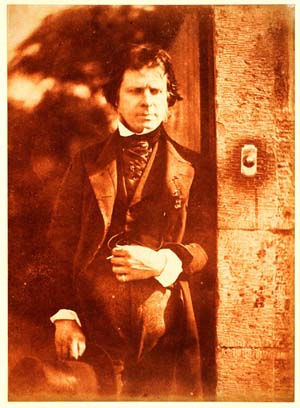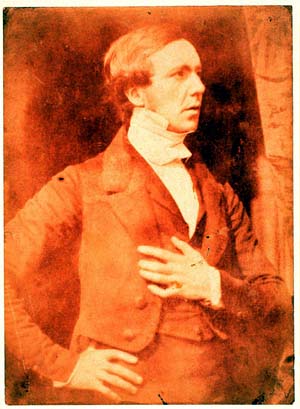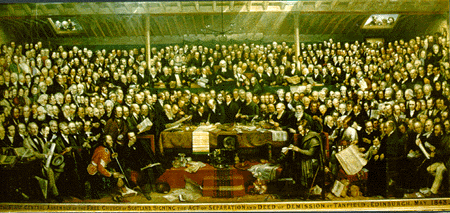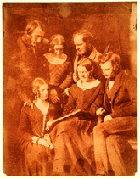David Octavius Hill & Robert Adamson
 The partnership of David Octavius Hill (1802-1870; shown in photograph on the left (HA0133)) and Robert Adamson (1821-1848) is one of the most significant and intriguing in the history of photography. The art of photography was announced to the public in 1839. Just four years later, in 1843, Robert Adamson established his studio in Rock House, on Calton Hill in Edinburgh. It was to be the site of some of the most sophisticated photography ever created - in early years on through to the present day.
The partnership of David Octavius Hill (1802-1870; shown in photograph on the left (HA0133)) and Robert Adamson (1821-1848) is one of the most significant and intriguing in the history of photography. The art of photography was announced to the public in 1839. Just four years later, in 1843, Robert Adamson established his studio in Rock House, on Calton Hill in Edinburgh. It was to be the site of some of the most sophisticated photography ever created - in early years on through to the present day.
Robert Adamson had enjoyed an intense upbringing in the fledgling art at St Andrews. His brother, Dr John Adamson, was a colleague and close friend of Sir David Brewster. Brewster had a unique relationship with the inventor of photography on paper, William Henry Fox Talbot. The two scientists shared information and experiences in photography with a freedom and openness unknown elsewhere in the beginning days of the art.
Robert Adamson, trained as an engineer and very clever indeed, was the full beneficiary of a legacy of innovative experimental information. This was critical at a time when all photographic materials were made by the photographer himself. The painter, David Octavius Hill, was highly popular and influential in the Edinburgh artistic community. His brother, Alexander Hill, was a premier publisher of prints. Between them, they had extensive contacts with society in Edinburgh and beyond.
The partnership was born in extraordinary circumstances. Almost simultaneously with Adamson opening his pioneering studio, the Church of Scotland was meeting in Edinburgh. In May, 1843, four hundred ministers - a third of the entire church - signed a Deed of Demission, resigning their livings and establishing the Free Church of Scotland. It was a true act of courage, rooted in deeply held convictions, for these men were not only surrendering their career, but also condemning their families to ostracism from the communities in which they lived.
 This violent act of separation deeply impressed many, including D.O. Hill. He announced the undertaking of a great commemorative painting, to include all those present, which would be the basis of an engraving. As the many ministers would soon scatter throughout Scotland, it was Hill's friend Sir David Brewster who suggested a way to make the recording practical. Brewster introduced Hill to Adamson and overcame the artist's skepticism as to the value of photography. The two men soon entered into an enthusiastic partnership.
This violent act of separation deeply impressed many, including D.O. Hill. He announced the undertaking of a great commemorative painting, to include all those present, which would be the basis of an engraving. As the many ministers would soon scatter throughout Scotland, it was Hill's friend Sir David Brewster who suggested a way to make the recording practical. Brewster introduced Hill to Adamson and overcame the artist's skepticism as to the value of photography. The two men soon entered into an enthusiastic partnership.
In their photography, Hill and Adamson produced calotype negatives. These were made on sheets of writing paper treated with light sensitive chemicals. Exposure times could run into several minutes in sunlight. The cameras were necessarily bulky as enlarging was not possible. The negative, which had to be the size of the final print, was printed by contact in full sunlight on a hand coated salt paper. Each negative and print had its own character. The prints were typically purple to reddish brown in tone, emphasizing broad masses of detail. They were frequently compared by contemporaries to the work of Rembrandt.
The initial idea of taking likenesses to be copied into the painting naturally led Hill & Adamson into portraiture. Their subjects rapidly extended beyond the ministers of the Free Church, and it is for portraiture that they are best known. However, they also did important architectural and city views, some landscapes, and photographs that were designed to document ways of life. The most famous of these is the extensive series done on the Newhaven fishermen and women.
This fruitful partnership was cut tragically short by the early death of Robert Adamson. Seriously ailing by 1847, he died at the beginning of 1848. Earlier scholarship by art historians often credited Hill as the sole author of the work - some later historians had disparagingly added "with Adamson" as a credit. Today it is recognized that the partnership was crucial to the production of their work. Robert Adamson's work was technically proficient but lacked flair and spontaneity before he met Hill. Equally, D.O. Hill's photographic efforts after the death of Adamson were dismal. It is clear that both men played a crucial role in the creation and the execution of the final images.
Incredibly, Hill & Adamson produced an estimated 3000 images in the less than four productive years of their partnership. Hill's painting of the Disruption - the original stimulus for their photography - was not completed until 1867. It is deservedly forgotten today, overshadowed by a body of photographic work from the earliest days of photography that in many ways has had no equal since.

The First General Assembly of the Free Church of Scotland; signing the Act of Seperation and Deed of Demission - 18th May 1843 (D.O. Hill RSA).
Image © Free Church of Scotland, Photograph by George T. Thompson LRPS.
The University would like to express its thanks to the Free Church of Scotland for permission to use George T. Thompson's photograph of The First General Assembly of the Free Church of Scotland; signing the Act of Seperation and Deed of Demission - 18th May 1843 (D.O. Hill RSA)
Go to next section: The Disruption Picture
Quick Links
- Hill & Adamson Search
- More material on Photography
- Special Collections A-Z
- Search for rare books
- Search for manuscripts
- Order copies/images
- The Adamson Family, mid 1840s: Robert Adamson is seated on the far right (HA0336)


